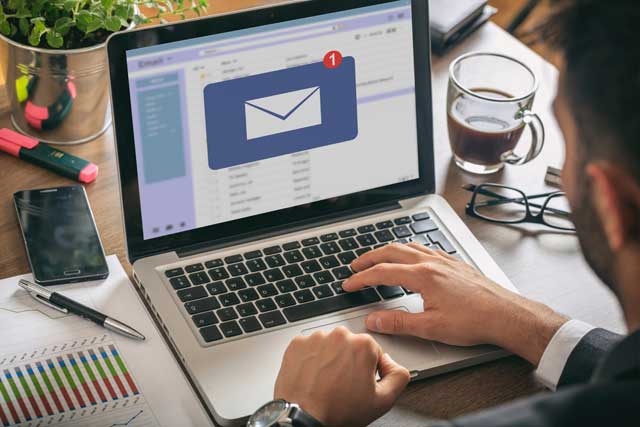Now that you have learned not only how to create a LinkedIn account, but how to build an effective profile, it is time to learn how to establish an effective network of contacts.
To begin your search, upload contacts currently stored in email accounts. By uploading contacts from your current email accounts, you can easily select the individuals you would like to invite to your LinkedIn profile.
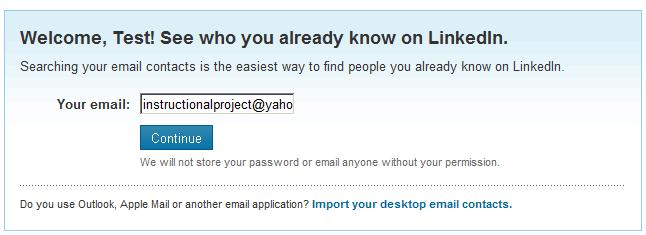
Alternatively, you can enter in email addresses manually that you know off hand.
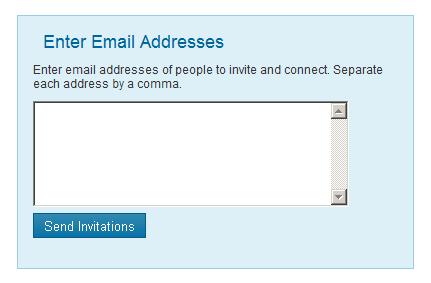
Once you have tackled the basic contact uploading process, you can begin to search for contacts in a more structured fashion.
Once you have finalized your profile's information, LinkedIn will actually be able to suggest contacts for you, using information about former colleagues, classmates and other people you may know. This is a great way to find people not currently on your radar screen.
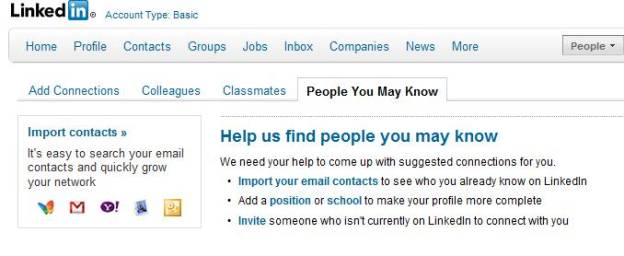
Moving forward, whenever you log into your LinkedIn account, suggestions will be provided of people to add to your list of contacts. Now that you have successfully uploaded the people whom you already know or have made contact with, how do you expand your network?
Post Updates
Now that you have started to build your LinkedIn network, you need to remain in contact with them. The adage, 'out of sight, out of mind' certainly applies in the world of networking. One of the easiest methods of regular communication on the LinkedIn site is to post regular profile updates.
Like Twitter, your status updates are limited to 140 characters. Here are some tips to keep in mind when posting updates:
o If you are linking to a blog/article post, be sure to use a service such as Bitly to shorten the post so that it fits within the character limit.
o If you find something of interest online, such as a news piece or article post, be sure to share it with your network.
o If you come across a great quote, such as something inspirational, feel free to share it in your update box.
o If you come across a relevant YouTube video, share the link with your network.
o 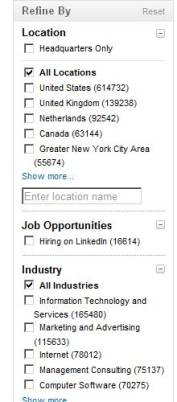 Any important announcement about yourself or your company should be shared.
Any important announcement about yourself or your company should be shared.
Ultimately, anything of relevance or importance would be great to share in your LinkedIn updates. To remain visible, make a note to post something at least weekly.
Your professional network involves more than the people you simply have regular contact with; it involves companies you currently, or have done business with in the past as well as casual contacts. The strength of someone's network often dictates the number of opportunities they are presented with. So, keeping this in mind, let's discuss how you can meet and connect with more people.
Utilize LinkedIn's Company Search
To begin, navigate to the "Companies" tab located at the top of your profile's dashboard. Next, select "Find Companies". From this page, you can refine your search, using the following parameters:
o Location
o Opportunities
o Industry
The search results will show not only a list of options, but for each company listed, the number of your people who have also connected with this particular business. To view these people, simply click the highlighted button specifying the number of people in your network that are associated with the company. For a more refined search, from the next page, you can choose to "View All" connections. From here, you can connect with people that you are associated with, thus adding additional contacts to your LinkedIn profile.
Once you have added new connections, it is important to reach out to connect on a more personal level. You can 'like' their comments, share information or comment on their status updates, invite them to local events or invite them to join any groups that they may be interested in from your list. This tool will open up a larger base of possible contacts for you, simply and easily.
LinkedInAnswers
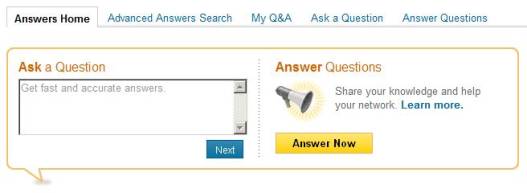 LinkedIn Answers is one of the best places on the web to share business knowledge with interested parties. Thus, it is a fantastic way to expand your network. The Answers platform enables you to ask questions, gaining accurate answers not only from your current network, but from members worldwide. In addition, you can showcase your own knowledge and expertise, by proving your own answers when questions are posed in your area(s) of expertise.
LinkedIn Answers is one of the best places on the web to share business knowledge with interested parties. Thus, it is a fantastic way to expand your network. The Answers platform enables you to ask questions, gaining accurate answers not only from your current network, but from members worldwide. In addition, you can showcase your own knowledge and expertise, by proving your own answers when questions are posed in your area(s) of expertise.
To access LinkedIn Answers, simply select "Answers" from your profile's dashboard. You will be taken to the following screen:
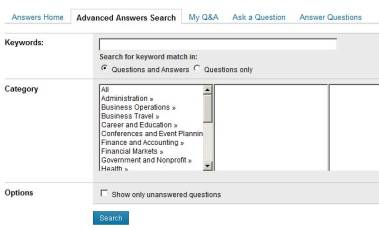 From this screen, you can post any questions that you may have in the "Ask a Question" box. To answer questions, you can click the "Answer Now" button, which will take you to another screen page. To use the advanced search option, for either questions to answer, or to pose your own questions, enter in more specific information. You can select by entering specific keywords, or by category.
From this screen, you can post any questions that you may have in the "Ask a Question" box. To answer questions, you can click the "Answer Now" button, which will take you to another screen page. To use the advanced search option, for either questions to answer, or to pose your own questions, enter in more specific information. You can select by entering specific keywords, or by category.
If you would prefer a more simplified manner for asking questions, you can utilize LinkedIn's suggested process, outlined below:
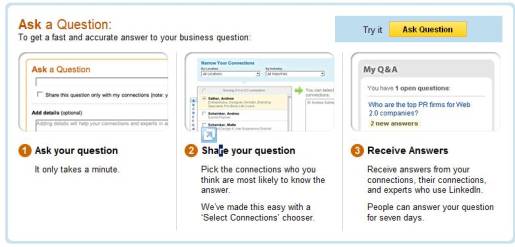
Asking a question is simple and easy. When posting questions, it is important to keep in mind that this platform is not intended, nor can it be used as, a recruiting tool, to advertise goods and service, or to post job openings. Any such post will be removed by the LinkedIn team.
Now that you understand how to properly ask questions, let's dive into how to answer questions.
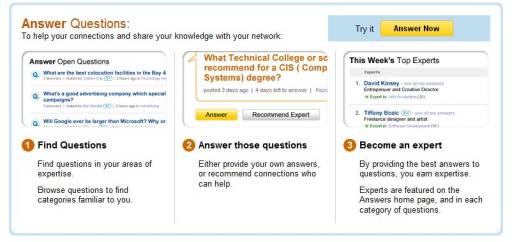
Whenever you answer a question, the information becomes part of your profile. This demonstrates your expertise to your current network, as well as potential employers or business associates.
In addition to searching for questions to answer using the information already provided, you can also respond to questions posed by your network, as you will receive a network update on your profile page whenever one has been posted.
In addition to appearing on your profile, your answers will appear under the specific question answered, as a network update on your connections' home pages, on your profile and in the form of an email sent to the person posing the question. If you don't want answers to be public, you can choose to answer privately.
Understanding LinkedIn Groups
Yet another way to build and maintain your LinkedIn network is through the usage of Groups. People of common interest come together within these groups to share valuable resources, pose questions to their peers, share event information for the group (meetings, conferences, etc.) and in many cases, to post job opportunities focused on a specific niche (financial services, healthcare, sales).
You can currently become a member of up to 50 LinkedIn Groups, and most networking experts suggest that you take advantage of every opportunity to connect, adding up to the limit.
To begin, consider searching for any of the following groups:
o College Alumnae
o Sorority/Fraternity Alumnae
o Non-profit organizations in which you are currently involved with
o Special interest (animals, traveling, hobbies, etc.)
o Industry Specific (financial services, healthcare, journalism, sales)
You can also search for groups using keywords, as well as by category, which includes:
o Alumnae
o Corporate
o Conference
o Networking
o Non-Profit
o Professional
You can also search the entire network of LinkedIn Groups by using this link:
http://www.LinkedIn.com/groupsDirectory?results=&sik=1304055844060. If you haven't reached your limit of 50 groups, consider searching this directory for groups fitting into any of the categories outlined above. Or alternatively, search for groups with the greatest number of members, thus providing you with even more individuals to possibly connect with.
The biggest benefit of joining groups, next to the companionship and friendships that can result from networking amongst people of common interests, is the opportunity to expand your online network to even greater lengths through interactions with the group's members.
Once you have successfully joined a LinkedIn Group, the individual members of that group are considered a part of your network, because you are both members of the same group. This doesn't mean that the members of every group you are a part of become automatic connections of yours, via your profile. What it does mean is that you can now interact with these members, which would otherwise be limited by the site when using a Basic profile. Look at Group members as a greater extension of your immediate network!
Interacting with Group Members
Joining a group isn't enough; you must interact with its members to build your network. Here are some Group interaction suggestions:
o Post comments where appropriate to other member's posts. Look for people within the groups that you may already be associated, asking them to join your direct network.
o Locate the most popular discussions within the group and jump in; add comments, leave feedback, etc.
o Start your own discussion.
o Visit your groups regularly. You won't be able to actively participate in all 50, but you can narrow down your list and interact regularly with a few targeted groups to get noticed.
As with any social media platform, regular participation will yield the greatest results either for your business or for your personal network. In some cases, you may not come across the specific group you are hoping to join. In this event, simply create your own.
Creating a Group
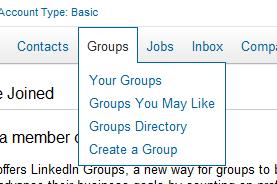 From your LinkedIn's dashboard page, click "Groups" from the options, then when the drop down menu appears, select "Create a Group."
From your LinkedIn's dashboard page, click "Groups" from the options, then when the drop down menu appears, select "Create a Group."
The next page will enable you to create a custom group page with a few simple data inputs.
To begin, if your group has a logo or image that will be used to identify it; you can upload it, to a maximum size of 100kb.
In addition to uploading a customized image or logo, you will need to provide the following information to successfully create a LinkedIn Group:
o Group Name
o Group Type
o Summary of the Group's Purpose/Objectives
o Group Description
o Website or URL
o Group Owner's Contact Email
o Requested Group Access Controls
o Language
o Agreement of Confirmation
Upon successfully entering this information, click "Create Group" and you're done!
Now that you have created a LinkedIn Group, it is time to promote it. Here are some great strategies to help you get started:
o Invite coworkers, former colleagues and current customers to join.
o Promote your group on your company's website/personal website, blog, in your email newsletter and on other social media platforms used.
o Invite targeted industry experts to join and engage in discussions.
o Cross market this group with other groups you may have created on social media sites (i.e. Facebook Group page).
o Integrate your LinkedIn profile and LinkedIn Group into all marketing efforts launched moving forward.
Now that you have an established LinkedIn Group and members to boot, you need to learn how to properly manage it for optimal effectiveness.
To manage your LinkedIn Group, keep the following suggestions top of mind:
o Regularly add news, job opportunities and discussions for members to review and leave comments about
o Send announcements
o If you have a current blog, import the RSS feed
o Use featured discussion to highlight important messages or offers
Creating and managing your own LinkedIn group can help establish you as an expert authority in your field. Plus, it opens up a broader network for you to interact with than simply joining Groups alone.
Joining existing LinkedIn Groups, as well as creating one of particular interest of yours, are both proven strategies for building your list of contacts on the platform. Once you have joined Groups, it is important to interact with their members. Simply joining groups and asking everyone to become a contact of yours isn't an effective networking strategy.
Using many of the strategies already covered, it is critical that you interact with the group and its members regularly to gain traction.











